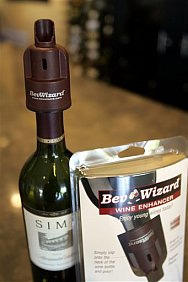 |
 |
 |
 Technology News | August 2006 Technology News | August 2006  
Magnetic Gizmo Aims to Mellow Young Wine
 Michelle Locke - Associated Press Michelle Locke - Associated Press


| | Shown is the Bev Wizard, a device that is supposed to make inexpensive wines taste better, at Copia, the American Center for Wine, Food, and the Arts in Napa, Calif., Friday, June 30, 2006. The new wine gadget promises to save pennies and palates by using magnets to smooth out the edges of brash young wines. Scientists and skeptics scoff, but the Bev Wizard, retailing at $30, is attracting attention in wine circles. (AP/Eric Risberg) |
Napa, Calif. - A new wine gadget promises to save pennies and palates by using magnets yes, magnets to give brash young wines some polish.

Skeptics scoff, but the Bev Wizard, retailing at $30, is attracting attention in wine circles.

The wizard is the invention of Patrick Farrell, a physician by training who is also a master of wine, a certification administered by the London-based Institute of Masters of Wine that is widely recognized as a rigorous demonstration of expertise.

Farrell started out tying magnets to the neck of a bottle at the urging of business acquaintances who were distributing magnets to try to improve water quality. At the time, he thought the chance magnets would work on wine was "about the same as seeing pigs fly."

But, he says, "I took the thing home, put it on a bottle of shiraz from Australia and was shocked to see it made it taste smoother and fruitier. So then I went down to my cellar and I got a bottle of Bordeaux from the Medoc and it made it taste softer and fruitier."

Eventually, he came up with a molded plastic device that looks like a regular non-drip pourer and has an air hole to speed up oxygenation. That intensifies the effect of the wizard and differentiates it from other magnetic devices on the market such as The Wine Clip, which clasps around the bottle neck, says Farrell.

He theorizes the wizard works by creating a magnetic field that changes the shape of a wine's tannins, making them larger and softer. Tannins are astringent components from grape skin and seeds, and in some cases oak, that give structure to a wine but can make it taste bitter.

Bottle aging can mellow out the tannins as can decanting hours prior to drinking; the Bev Wizard is a shortcut, says Farrell.

Chemistry professor David W. Ball is having none of it.

"Testimonials are irrelevant. Tastings are not proof," says Ball, a professor at Cleveland State University, and "amateur wine snob," who says magnetic fields aren't strong enough to change the shape of tannins.

"All that magnetic field is doing is separating you from your money," says Ball, who won't be trying the Bev Wizard any time soon.

But Farrell says his device works and that the proof's in the drinking.

"Obviously, they're wrong," Farrell says of critics, contending it's hard to criticize a device without trying it. "I was beyond skeptical. I was cynical that it was going to have any effect, but at least I had some intellectual curiosity."

Others find the gadget more appealing.

"It's interesting," said Peter Marks, director of wine at Copia, the Napa Valley center for wine, food and art.

Marks, also a master of wine, knows Farrell but was a doubter when he first tried the device.

He didn't see much difference in his first quick sample, but later arranged a blind tasting of wines under $10 with some friends who enjoy wine and found that most of the group could tell a difference and they preferred the magnetized version, particularly on lower-priced wines.

That, says Farrell, shows the device works. (Informal tests with a group of enthusiastic and, in some cases, relatively expert wine drinkers found that all saw a difference between wines with and without the magnet, including some who didn't know the device had been used.)

But Ball theorizes oxygenation the way wine changes as it's exposed to air may be responsible as well as the generally subjective nature of wine tasting.

Farrell is working on setting up a study to provide a chemical analysis of any changes taking place.

Meanwhile, he's got another pourer on the market specifically for wood-aged liquor, such as whiskey, and is working on developing magnetic pourers for other potentially bitter beverages such as coffee, tea and grapefruit juice.

Farrell says his device doesn't do much for high-end premium wines. Even with the cheaper varieties like the $1.99 Charles Shaw wines at Trader Joe's supermarkets he's not promising miracles.

"You can turn Two Buck Chuck into Five or Six Buck Chuck," he says, "but not Twelve Buck Chuck." | 
 | |
 |



